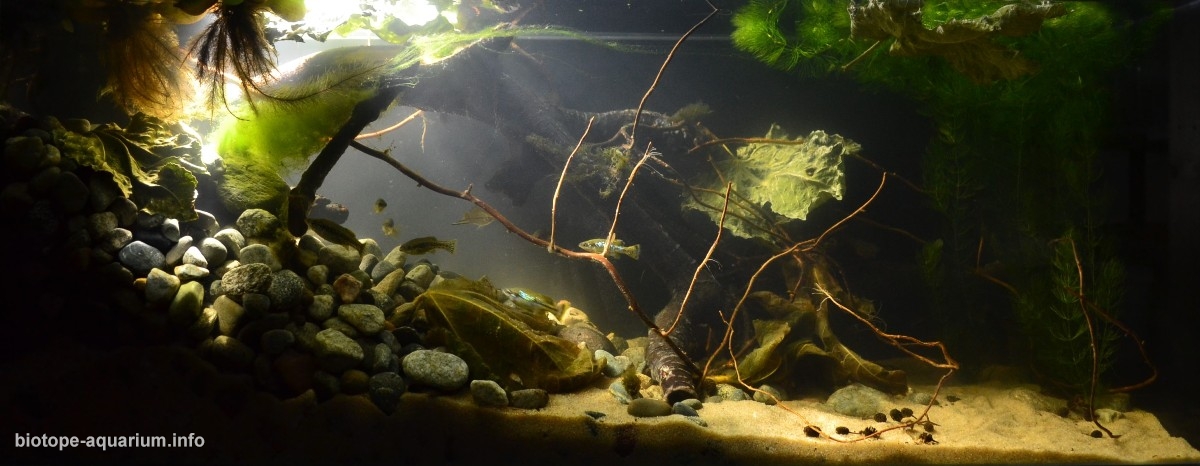Ameca River, shoal near the coast near San Antonio Matute, Jalisco, Mexico
49th place in Biotope Aquarium Design Contest 2019
Russia. Oleg Blinov

Volume: 120 L
Dimensions: 92х36х37 cm
List of fishes: Ameca splendens, Xiphophorus hellerii
List of plants: Ceratophyllum demersum, Fissidens fontanus, Eichhornia crassipes, Spirogyra sp.
Description of decorations: Alder roots (Alnus spp.) are common in Mexico along the rivers. The roots and branches often create shelters in the coastal zone of shallow water for various inhabitants. At the bottom you can see alder cones falling from the trees, as well as fig leaves (Ficus carica). The bottom is covered with white quartz sand (0.5-1 mm), just like in the photo of travelers who were on the banks of the Ameka River. Closer to the shore, the sand is carried away by the current and exposes river pebbles of various fractions.
Description of equipment: External filter Tetra ex600 plus 600 l/h, internal filter AQUAEL FAN-2 plus 450 l/h (the role of a flow pump), LED spotlight 30 W 6500K.
Water parameters: Temperature 26°C, pH 7.0, KH 6, GH 22, NO2 nitrites 0 mg/L, NO3 nitrates 10 mg/L, ammonium NH4 0 mg/L.
Additional info: Weekly water changes of 30% of the volume.
INFORMATION ABOUT BIOTOPE
Description of the area surrounding the biotope: Ameca is a small coastal river in Mexico from the Pacific Ocean, which flows through the state of Jalisco and flows into the Gulf of Banderas. In her last section, it forms the border between the states of Nayarit and Jalisco. It is 230 km long and occupies a basin of 12,214 km². It originates only 23 km west of the city of Guadalajara and runs west. The river got its name from the city of Ameka, which it crosses. Among its main tributaries are the Auacatlan and Amatlan de Cañas rivers. Ameka was dammed north of the city of La Vega, forming a reservoir, Lake La Vega, which extends north to the city of Teuchitlan. The course of the river changes from medium to strong, depending on the nature of the area. In some places there are backwaters. The banks are mostly densely covered with low vegetation (Acmella repens) and deciduous trees: Alnus spp., Ficus carica, Ilex spp., Corylus spp., Viburnum spp. Their roots sink into the water, forming an underwater jungle overgrown with green algae in bright sunlight. Such places were previously natural biotopes of Ameca splendens until the species disappeared as a result of active human activity in the region, where other representatives of the aquatic fauna are also at risk.
Description of the underwater landscape of the biotope: Ameca splendens are able to live in muddy streams with silt, sand and gravel, but they prefer clean warm areas where the current is moderate. Here, among the driftwood from the coastal trees, near dense thickets of underwater flora (Ceratophyllum demersum, Potamogeton sp., Fissidens fontanus) and under the cover of Eichhornia crassipes, the Ameks found their food – diatoms and filamentous algae (mainly Ulotrichales, Zygnemonialesles and Oedogoniales) which most affect tree roots, roughness of boulders and pebbles, developing with the flow of their threads. The diet of Ameca splendens also included mosquito larvae, copepods and oligochaetes, as well as small insects and spiders falling on the surface of the water. Among the boulders, snag, and thickets, Ameca flocks shared their territories with Xiphophorus hellerii, Goodea atripinnis, Poecilia mexicana, Pseudoxiphophorus bimaculatus, and Oreochromis aureus. The bottom of the channel is covered with fine light sand with accumulations of silt in the backwaters. Closer to the shores, the sand recedes and exposes pebbles and boulders in shallow water.
Description of the parameters of the habitat: Water, basically, is pure, in the rain there is turbidity from the flow of dirt from the coast. Temperature 25-27°C, pH 6.6-7.9, KH 19-30, nitrites NO2 0-0.002 mg/L, nitrates NO3 0.2-1 mg/L, ammonium NH4 0-0.08 mg/l
List of fishes and invertebrates occurring in the nature biotope: Ameca splendens, Xiphophorus hellerii, Goodea atripinnis, Poecilia mexicana, Pseudoxiphophorus bimaculatus, Oreochromis aureus, Zoogoneticus purhepechus, Zoogoneticus tequila, Notropis amecae, Ictalurus dugesii.
List of plants found in the nature biotope: Ceratophyllum demersum, Fissidens fontanus, Eichhornia crassipes, Potamogeton sp., Pistia stratiotes, Spirogyra sp., Ulotrichales sp., Zygnematales.
Threats to the ecology: Ameca splendens is the central species of ichthyofauna presented in this biotope aquarium. And the fact is that this species officially has the status of extinct in the wild. In recent years, there is not a single confirmed fact of the discovery of Ameca in its natural habitat. This once again shows human irresponsibility in the use of natural resources. The transformation of the Ameca River into a canal for the discharge of household waste, garbage, livestock grazing from farms, and the creation of artificial dams led to a similar disaster in many small reservoirs in Mexico. Endemic to these biotopes are endangered like Ameca splendens. Fortunately, the world community of aquarists stored Ameca in aquaria. This biotope aquarium has already been inhabited by 2 of their generations, which were bred and grown on their own. We are actively promoting this species with a view to its wider distribution in home aquariums. The achievement of this goal is the creation of a biotope aquarium of the Ameca River section, which shows the beauty of extinct fish in its natural habitat and supports its population at least at home!
Sources of information:
Articles:
https://es.wikipedia.org/wiki/
http://www.
https://www.aquainfo.org/
https://notdennis51.wordpress.
https://botsad.ru/menu/mir-
https://riosdelplaneta.com/
https://www.tandfonline.com/
Photos with geolocation:
https://www.google.com/maps/
https://www.google.com/maps/
Video of the river:
https://www.facebook.com/
